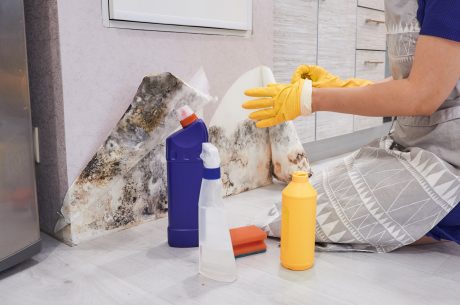Florida’s tropical climate is perfect for all kinds of outdoor fun, but the same humidity that makes it great for beach days can also lead to unwanted mold in your home. Mold spores love warm weather and humid environments, so Florida homes can become their favorite spot. This poses not just a threat to your home but also to your health.
Mold can creep into places like damp basements or around leaky pipes, spreading fast if not controlled. It can cause damage to your house and lead to health issues like allergies and breathing problems. Being proactive about mold prevention is crucial when living in such a damp environment. Understanding how mold thrives and taking steps to stop it can help keep your home safe and healthy. Let’s explore some practical ways to deal with mold before it becomes a bigger problem.
Understanding Mold Growth in Florida’s Humid Climate
Florida’s weather is a paradise for mold growth due to its high humidity and warm temperatures. Mold thrives in damp environments, and Florida’s frequent showers create an ideal setting. The regular high humidity levels mean that moisture tends to linger in the air, providing a continual supply of dampness that mold needs to grow.
Common types of mold found in Florida homes include Alternaria, Aspergillus, and Cladosporium. Alternaria often shows up on walls and textiles and can lead to allergies or asthma attacks. Aspergillus can appear in air conditioning units, while Cladosporium is usually seen in bathrooms and on wood surfaces. Each type can cause different health effects, including respiratory problems and allergic reactions.
In every home, certain areas are more prone to mold growth than others. Basements, due to their underground position, often hold more moisture. Bathrooms and kitchens, with constant water usage, are particularly susceptible. Additionally, spaces like attics and crawl spaces are at risk due to poor ventilation. Keeping an eye on these areas can help in stopping mold before it becomes a bigger issue.
Preventive Measures to Keep Mold at Bay
Controlling moisture is the key to preventing mold. Start by using dehumidifiers to lower humidity levels inside the home, especially during the rainy season. Fans can also help circulate air, reducing moisture buildup. Ensuring good air movement in areas like your bathroom and kitchen is essential.
Maintaining your HVAC system is another crucial step. Regularly changing air filters and getting your system serviced can prevent mold spores from spreading through your home. This halts a potential mold invasion before it starts. Additionally, using an air conditioner or heat pump with a drying mode can help reduce humidity levels.
Proper ventilation is another effective way to keep mold from settling in. Open windows or use exhaust fans in high-moisture areas to let damp air escape. In bathrooms, ensure that fans are in good working order to remove steam from showers. In the kitchen, use a range hood to vent moisture out when cooking. These steps help reduce moisture and make your home less inviting for mold growth.
Identifying Early Signs of Mold
Catching mold early can save you from bigger problems later. Mold often starts small, so learning what to look for helps nip issues in the bud. Look closely for discoloration and spots on walls, ceilings, and around windows. Mold can appear in shades of black, white, green, or gray. Pay attention to any musty odors as well, which often signal mold growing in hidden places.
Creating a checklist helps keep your home free from mold. Regularly inspect places like the basement, attic, and areas around sinks and appliances. These zones stay humid if not properly managed. Leak detection is key, so check under sinks and around bathtubs for early signs of water damage, which creates a breeding ground for spores.
Keep health symptoms in mind, as they might mean mold is present. Mold exposure can lead to allergic reactions like sneezing, coughing, and skin irritation. If symptoms crop up without an apparent cause, check for hidden mold. Identifying these signs early results in quick action, helping to safeguard both your home and well-being.
Safe Mold Removal and When to Call Experts
When you spot mold, dealing with it swiftly is important. For small patches, you can often handle cleanup yourself. Start by wearing safety gear like gloves, goggles, and a mask to protect yourself from spores. Use a mix of water and detergent to scrub the affected area. Dispose of cleaning materials in a sealed bag to prevent spores from spreading.
Have the right supplies ready when tackling mold. Essential tools include a scrub brush, clean rags, and a spray bottle with cleaning solution. You might also need a HEPA vacuum for capturing tiny spores. Remember to open windows and doors to ventilate your space, ensuring spores don’t hang around after cleaning.
There are times when professional help becomes necessary. If the mold coverage exceeds 10 square feet, or if it’s nested in tough-to-reach places like inside walls, it’s time to call in experts. Professionals have the experience and tools to remove large infestations safely. Knowing when to seek help ensures your home stays healthy without risking further mold spread.
Conclusion
A continuous effort helps maintain a mold-free home in Florida’s climate. Starting with awareness, homeowners can reduce the chance of mold taking hold by tackling moisture and practicing good home care. Knowing what mold likes and removing any potential breeding grounds makes a big difference.
Educating yourself and others on preventing and addressing mold can help build a community less affected by its presence. Mold need not disrupt your life if proper measures are in place. Awareness and action form the best defense, providing peace of mind against unwanted spores.
If mold issues grow beyond what you can handle, PuroClean of Marco Island is ready to assist you. Our team specializes in mold removal and prevention, ensuring your home stays clean and safe. Contact us today to learn about our services and how we can help keep your property healthy through Florida’s challenges.



